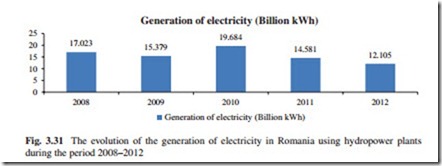Romania
The first hydropower plant in Romania, which was documentarily attested, was the Grozavesti plant built in 1889 on the Ciurel Lake, Bucharest, and having a 2 × 180 HP power. It has been in operation until 1912 when it was replaced with TPP Grozavesti (Cristescu and Dadu 2003). In 2012, the total hydropower capacity installed in the country reached 6,412 MW, which represents 28.11 % of the total electricity capacity installed. Within the total renewables capacity installed in the country, hydropower represents 76.61 % of the total. During the past 10 years, the use of hydropower plants for the generation of electricity increased in eight of the ten-year period considered. The annual average growth rate was 0.26 %.
Despite of the early use of hydropower plants for the generation of electricity in the country, in 2014 Romania announced its decision to suspend the construction or operation of hundreds of small-scale hydropower plants in protected areas across the Carpathian mountains, in order to protect regional biodiversity and aquatic ecosystems. The decision came in response to a petition signed by over 18,000 Romanian citizens requesting the government to legally protect mountain streams, which constitute the habitat of many valuable and endangered species. The petition highlighted the risks and cumulative impacts of small hydropower plants and of construction without strategic planning at river basin level and at national level as well as without appropriate environmental assessment. It further decried the currently ambiguous legal framework on the matter and emphasized the lack of well-defined criteria to establish exclusion zones, areas that should be protected from hydropower plants.
While small hydropower plants do not involve the construction of a dam, it requires diverting part of the river’s flow through a pipe to a downstream turbine generating electricity. In many cases, the pipes are inserted into the riverbed, instead of being placed parallel to the stream or above it, and divert around 80 % of the water flow to a downstream turbine generating the electricity. This process dries up smaller rivers and has been destroying protected areas in the Carpathian mountains.
It is important to highlight that small hydropower plant constructions in Romania were stimulated by generous EU subsidies and poor oversight from the Romanian authorities. The country has promised to increase the proportion of electricity from renewable resources to 35 % by 2015 and 38 % by 2020. For investors, small hydropower infrastructure was appealing, because of its ability to adapt to fluctuation in electricity demand, in ways that wind farms cannot.
Romania, whose second most important source of electricity generation is hydroelectricity,22 has already been the first country to accept the sustainable hydropower guidelines put together by the International Commission for the Protection of the Danube River. It has also started the legal proceedings to designate exclusion zones and adopt pre-scheduling mechanisms for the development of hydropower on the Danube.
Hydropower Installed Capacity
Romania has an estimated total hydropower potential of 36,000 GW per year. Romania co-owns the Iron Gate in hydropower plant on the Danube River located on the border between Romania and Serbia, which is one of the largest hydro- power plants in Europe with an installed generation capacity of 2,216 MW (six generating units of 175 MW each on the Serbian side and six generating units of 194.4 MW on the Romanian side). The two countries also jointly operate the Iron Gate II hydropower plant with an installed generation capacity of 537 MW (eight generating units of 27 MW on the Serbian side and ten generating units of 32 MW on the Romanian side).
The largest hydropower plant on the inner rivers of Romania is the LotruCiunget hydropower plant with an installed generation capacity of 510 MW, but this hydropower plant will be surpassed by the Tarniţaa˘pus¸tes¸ti hydropower plant, which at completion in 2014 will have an installed generation capacity of 1,000 MW.
Hydroelectricity Generation
According to the Romania Energetic Strategy for 2007–2020, the evolution of the installed hydropower capacity is expected to be 8.4 GW in 2030 and 9.3 GW in 2050, and the estimations of the electricity production are 22.6 TWh in 2030 and
25.1 TWh in 2050.
The evolution of the generation of electricity in Romania using hydropower plants during the period 2008–2012 is shown in Fig. 3.31.
According to Fig. 3.31, the generation of electricity in Romania using hydro- power plants during the period 2008–2012 decreased 29 %. However, during the period 2008–2010, the generation of electricity using this type of energy source increased 15.6 %. After that year, the generation of electricity using hydropower plants decreased significantly (30.6 %). However, with new hydropower plants beginning their operation after 2014, it is expected that the participation of hydro- power in the energy mix of the country will increase once again during the coming years. The annual hydropower potential in Romania has been estimated at 36 TWh.
